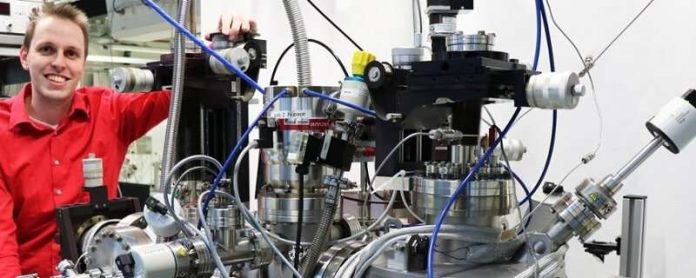
Have you ever wondered how the gas in your car turns into energy?
Or how a hydrogen fuel cell works? It all comes down to a simple yet very important chemical reaction that happens on the surface of a catalyst, like platinum.
Catalysts help speed up chemical reactions without being used up themselves.
For nearly 40 years, scientists have been trying to figure out the exact process behind one of these reactions involving hydrogen and platinum.
There have been two main theories, or models, about how this happens, but no one could say for sure which one was correct. But finally, thanks to a unique platinum surface that’s curved like a slide, chemists from Leiden, Eindhoven, and the Dutch Institute for Fundamental Energy Research (DIFFER) have figured it out.
They published their findings in the journal “Science” on January 11th.
Chemists Ludo Juurlink, Ph.D. student Richard van Lent, and Michael Gleeson from DIFFER came up with a new way to test the two models. They looked at how the reaction changed when they altered the structure of the platinum surface.
“Because the platinum surface is curved, the atomic structure changes very gradually along the surface,” explains Juurlink. “You can compare this structure to a staircase, where the steps towards the edges become narrower and narrower. In the middle, it looks more like a ballroom.”
They found out that the reactivity of the hydrogen, which means how willing it is to react, depended on how close the “steps” of the atomic structure were. The further apart the steps were, the less reactive the hydrogen was. This proved that the model predicting a non-linear behavior was incorrect.
Their experiment was carried out in an ultra-high vacuum, meaning there were almost no other molecules around to interfere with the reaction. Juurlink said this gives us better knowledge of how to calculate the speed of chemical reactions and helps us understand how reactions occur on surfaces. He believes that it opens up new opportunities for further research.
This finding could be pretty important because catalysts are used in many chemical processes, including fuel cells and car exhaust systems. Plus, some catalysts, like platinum, are pretty rare and expensive.
“The unusual thing is that we usually don’t even really know how and why such catalysts speed up chemical reactions,” says Juurlink.
This research brings us one step closer to understanding the secret behind the catalysts. This could help make chemical processes more efficient, sustainable, and maybe even less reliant on expensive materials.



